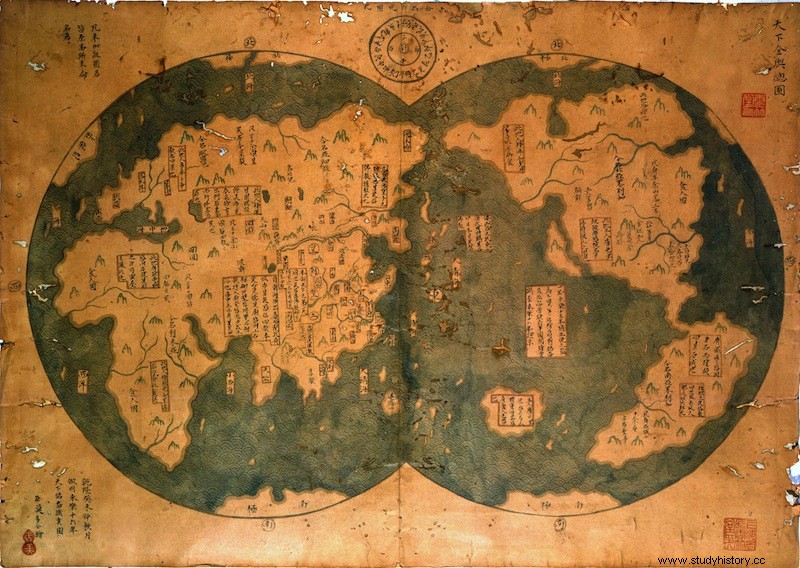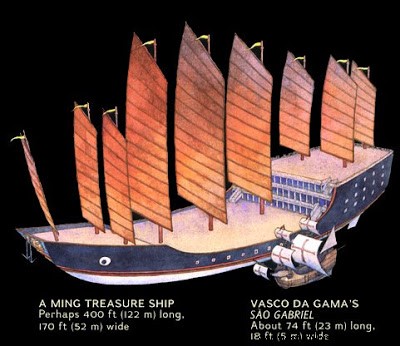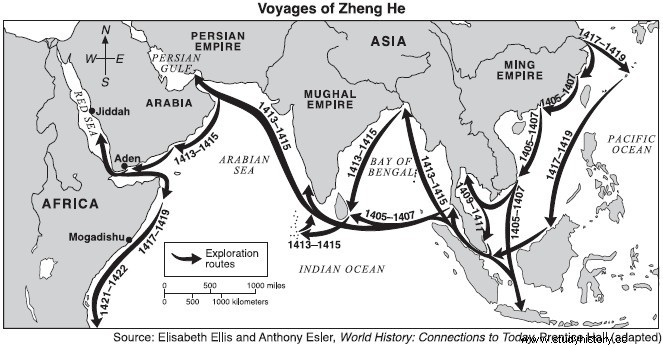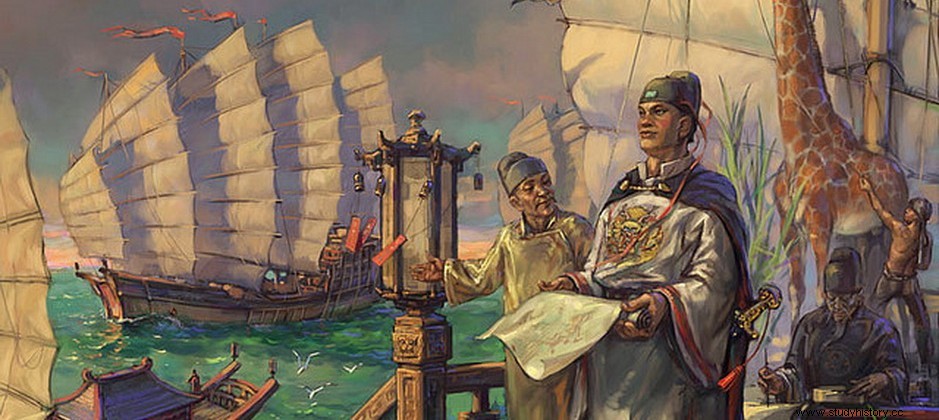We have all learned during our school years that Christopher Columbus he "accidentally" discovered America on October 12, 1492, Rodrigo de Triana's "Tierra a la vista", the caravels Pinta, Niña and Santa María, the subsequent voyages and everything that that historic moment meant for Spain. It is also true that Christopher Columbus was not the first European to set foot on the American continent; years ago, around the year 1000, the Vikings of Erik the Red and his son, Leif Eriksson , came from Greenland to the shores of Newfoundland in Canada, the stories of the Vinland Sagas (Saga of the Greenlanders and the Saga of Erik the Red) being famous. . The settlement of L’Anse aux Meadows it is a proof of it; however, the Viking colonization of the "New World" failed due to famine, inclement weather, and attacks by hostile tribes such as the Micmac or Surike (called Skraeling by the Vikings), causes that led the Vikings to withdraw from «Vinland » and abandon their plans. To date, both Columbus and his men and the Vikings who arrived from Greenland to the east coast of Canada, are properly considered as discoverers... and there are also other hypotheses and cases that add to said discovery, the best known being that of the enigmatic map of the Ottoman admiral Piri Reis (Everything points to the fact that a map of Columbus himself was copied after the capture of some Spanish ships anchored in Valencia), or the case that concerns us in this story:Chinese admiral Zheng He and the Chinese treasure fleet .

Supposed map of Zheng He
In 2006, the news spread like wildfire that a copy of a map of Admiral Zheng He himself had appeared in Beijing. in which the American continent was already detailed. Said map was supposedly from 1418, no less than 74 years before the arrival of Columbus. Many people doubt the authenticity of said map, among other things, because of the detail with which it is drawn, because the copy shown was from 1763... and the compelling reason that leads us to think that China did not discover America is history itself by Zheng He.
Zheng He was born in 1372, in the village of Hedai , in the mountainous province of Yunnan, and was not always known by that name, his real name was Ma He . At that time, the Mongols had begun to decline in power and were replaced by the Ming. Zheng He's family had fought alongside the Mongols and belonged to an alien caste, namely the Hui (those who express themselves in Chinese and are Muslim). As a boy, he had been captured by the Ming and subsequently castrated. Already a eunuch, he was sent to Beijing to serve in the court of Prince Zhu Di (future emperor Yongle ), where together Zheng He and Zhu Di conspired to overthrow Jianwen , emperor at that time of China and nephew of Zhu Di himself. After the clashes, they took the capital, Nanjing, and in 1402 Prince Zhu Di was crowned Yongle emperor. . The Yongle Emperor is considered by many to be the "Chinese Peter the Great «, because the territories of China grew more and more. As a reward for his actions during the rebellion against the Jianwen Emperor, Zheng He was made an admiral. After attaining power, one of the Yongle Emperor's priorities was to promote maritime trade as an important and profitable source of income (an activity frowned upon until his arrival).
Zheng He, already as admiral, was entrusted with the difficult task of building a powerful fleet to sail and trade in the seas of the East. With some old and outdated maps, a few ships and hardly any crew, he set to work. He ordered the construction of gigantic shipyards on the banks of the Yangtze River, outside Nanjing, which between 1403 and 1407 were capable of manufacturing around 1,600 ships. This fleet was not created solely for economic purposes, but also to combat piracy, establish new diplomatic relations, search for exotic animals, medicinal plants... Zheng He's fleet was a true floating city made up of all kinds of ships, including highlighted the so-called «Treasure Ships «. Its true dimensions are unknown, since not one has been preserved, but it is estimated that they were 120 meters long, 50 meters wide and with more than 5 masts... a complete floating fortress that had little or nothing to do with other ships of the time in Europe.

Admiral Zheng He's imposing fleet made up to seven voyages through the seas and coasts of the East. Although there were soldiers on the ships, Zheng He did not use them for expansionist or colonialist purposes, rather as deterrent forces or as reinforcement troops to defend the interests of China's allies. To give us an idea of the benefits obtained from these trips, in 1412 he financed the construction of an 80-meter-high tower in Nanjing, the Porcelain Tower , destroyed in 1856 by the Taiping. China, during the reign of the Yongle Emperor, experienced unprecedented splendor:important architectural works were built such as the aforementioned Tower, the Forbidden City, repair works and construction of new sections of the Great Wall were resumed, trade prospered... 
Travels of Zheng He
The admiral's first voyage was in 1405, with about 320 ships and 28,000 men. During the more than two years that the expedition lasted, they visited Sumatra and Sri Lanka, confronted pirates near Malacca (Malaysia) and brought several foreign ambassadors to China. On the second voyage, the fleet and crew were much smaller than on the first (about 70 ships), as the goal was to return home the foreign ambassadors they had brought to China. On the third voyage, in 1409, the number of ships and men was even more modest, barely 50 ships, but they still visited Vietnam, Temasek (now Singapore), and again Malacca. These early voyages improved trade relations with Southeast Asia, but the Yongle Emperor set Zheng He on a new mission:the exploration of Arabia and Africa, places not entirely unknown to the Chinese.
On the fourth voyage, Zheng He left China in 1414 with about 63 ships and reached India and the Maldives. On this trip, as a curiosity, Zheng He arrived in China with the King of Bengal as a guest and he presented the Yongle Emperor with a «qilin » (a mythological animal similar to the unicorn that appeared when the rulers were just, although in reality it was simply a giraffe). Be that as it may, many congratulated the emperor for this auspicious symbol. On the fifth trip, already in 1416, Zheng He visited the usual ports of Southeast Asia and this time he did reach the Arabian Peninsula and Somalia. On the sixth voyage, the fleet repeated the usual destinations and Zheng He was invited to the opening of the Forbidden City.

Things began to go wrong in what would be the seventh and last voyage of the Chinese imperial fleet. The Confucianists, supporters of isolationism, again began to gain ground and importance in the Yongle Emperor's court, the construction of new ships began to decline after the remodeling of the Grand Canal in 1411 (this canal offered a much faster and safer route than the maritime), internal problems also began:famines, epidemics, deficit, inflation, war with the Vietnamese rebels in the north of the country... and the death of Zheng He's main supporter in 1424, the Yongle Emperor. Yongle's son, the Hongxi Emperor Despite the fact that he only reigned for 9 months, he was in favor of canceling the naval expeditions. Xuande , Hongxi's successor, faced with the crisis that hung over China, ordered preparations to begin for what would be Zheng He's last trip. In 1430, a fleet similar to that of the first voyage sailed from China with more than 300 ships. This great fleet was divided into two:one marched through Africa (reaching Kenya and Mozambique) and the other, with Zheng He in command, headed for the Persian Gulf. Zheng He passed away before reaching his destination and although he has a grave in China, it is empty. As a good sea dog, he was buried in the ocean. The fleet returned to China without its admiral but with new products, ambassadors and even several «qilin " plus. The situation fell apart with the death of the Xuande. His successor, Jungtong , only 7 years old, was captured by the Mongols in 1449. The Confucianists, with a strong presence at court, great influence in China and much more conservative than previous emperors, prohibited the construction of ships with more than two masts and maritime navigation through the Hai Jin edict . To prevent future waste, parts of Zheng He's voyages were "erased" by officials of the new Ming emperor. The Mongols were once again a serious threat in northern China and soldiers were needed to defend the borders, which made the high expense of maintaining the treasure fleets unsustainable.
Be that as it may, the expeditions of the Chinese imperial fleet ended decisively and this greatly favored European navigation and exploration. If he had continued with his expeditions, it is most likely that today in the south of the USA they would speak Chinese and not Spanish. As we all know, a few years later and from another part of the world, a certain Christopher Columbus set sail for...
Collaboration of Pedro Sanmartín
